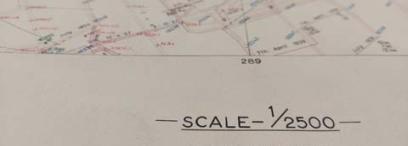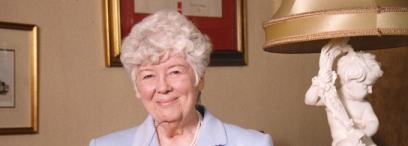In 1824, James Braidwood helped to establish the Edinburgh Fire Brigade – the first municipal fire service in the world. Prior to this, fire-fighting in the capital was undertaken by various fire insurance companies. A serious fire in Niddry Street, in February of that year, and another a few months later opposite the Royal Exchange (today the Edinburgh City Chambers), brought into sharp relief the realisation that the city needed an organised fire service to protect against the risk of fire.
Braidwood was born in Edinburgh on 3rd September 1800, the son of Janet Mitchell and Francis Braidwood, a prosperous cabinet maker, who had married on 16th August 1775 in Leith South parish.
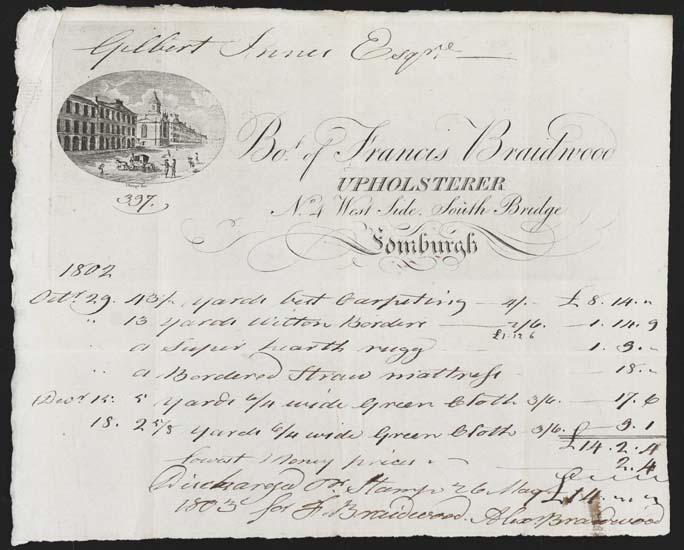
A receipt from Francis Braidwood’s workshop, 4 West Side, South Bridge, Edinburgh to Gilbert Innes of Stow, 26th May 1803. The engraving by Scottish engraver and printmaker John Beugo shows the South Bridge and Tron Kirk.
NRS, GD113/5/340/87
The surviving Old Parish Register (OPR) entries record that between 1778 and 1802, 11 children (including one still born boy) were born to Janet and Francis; four girls and seven boys. Many of these children were recorded in the OPR at one time:
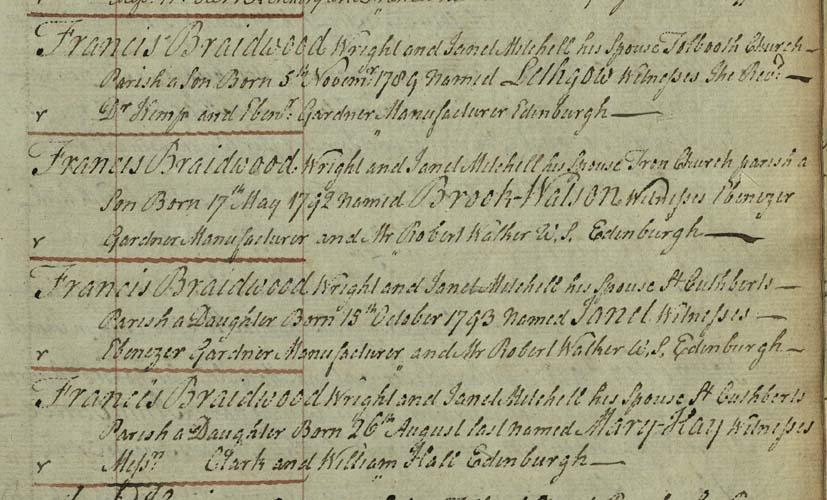
Four of the Braidwood children were recorded in the Old Parish Register for Edinburgh Parish on 28th November 1797
Crown copyright, National Records of Scotland (NRS), Old Parish Register of Births, 685/1 page 254
Although James was born on 3rd September 1800, his details weren’t recorded in the register until three years later. It can be seen in this entry, illustrated below, dated 29th August 1803, with the entry for his brother William who was born the previous year:
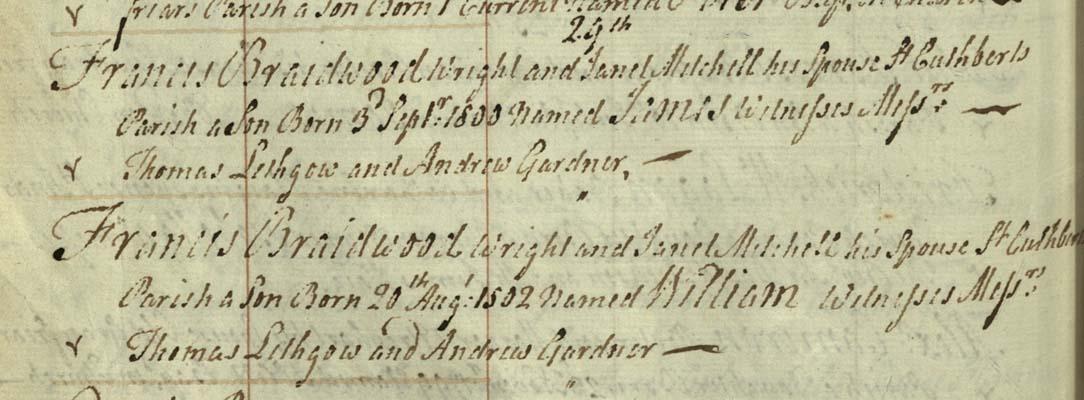
James Braidwood’s birth entry
Crown copyright, NRS, Old Parish Register of Births, Edinburgh, 1803, 685/1 page 165
Educated at the Edinburgh High School, he was trained as a surveyor where he gained in-depth knowledge of housing conditions in the city, as well as its topography, which would likely have been beneficial in his role within the fire brigade. By the age of 24, he had been appointed as Master of Engines in the fire service.
Following the devastating fires that year, a committee was formed, consisting of members of the police, magistrates, and insurance companies. Before any progress could be made, however, Braidwood and his men faced a demanding test of their abilities when a huge fire broke out at the Old Assembly Close in the High Street on the evening of 15th November 1824, when a pot of linseed oil had spilt, setting fire to a stack of paper. Within a couple of hours, the blaze was fierce, destroying tenements and spreading as far as the Tron Church.
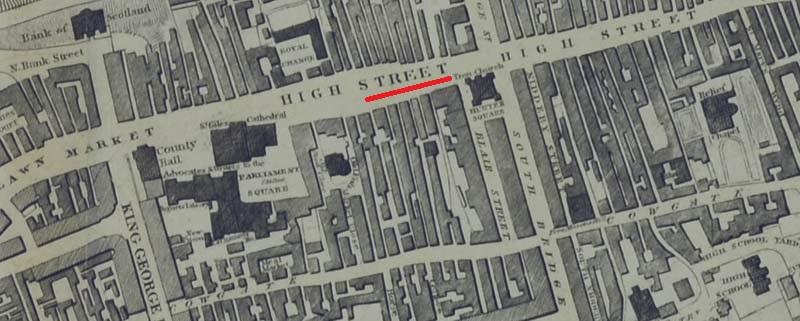
Detail from a plan of the City of Edinburgh, 1823. The red marker on the plan highlights the area where the fire spread. The Tron Church can be seen at the right edge of the marker. The entire plan can be seen on the ScotlandsPeople website.
NRS, RHP13044/16
The fire raged for three days and was fought by 22 engines. The resulting damage was estimated at £200,000, left 400 families homeless and killed 13 people. (Edinburgh Evening News, 27th May 1961).
After some discussion the committee agreed to supply Edinburgh with an improved fire service for an initial outlay of £1,400 (approximately equivalent to £80,500 today, according to The National Archive’s currency converter). Braidwood took up leadership of the fire brigade, managing 80 men who wore a uniform of white trousers, blue jackets and leather helmets. The available apparatus consisted of three engines, each operated by 20 men and using another four men to pull it through the streets. (Edinburgh Evening News, 27th May 1961).
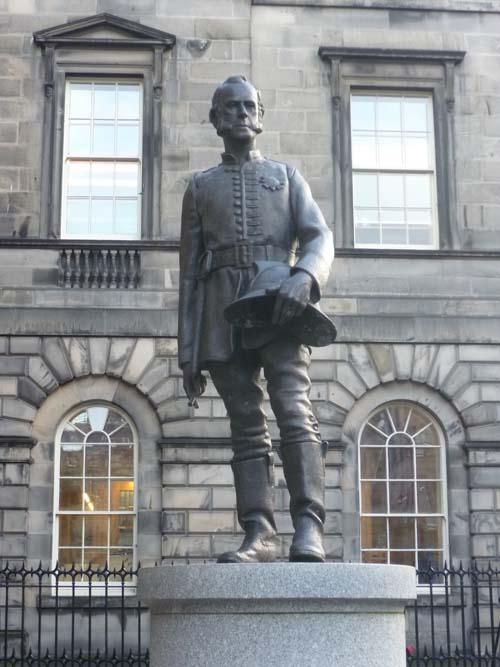
A standing bronze statue of James Braidwood, which was unveiled in Parliament Square, Edinburgh, on 5th September 2008 by Sir Timothy O’Shea, Principal of Edinburgh University. Part of the inscription on the pedestal reads ‘Father of the British Fire Service.’
Credit: Wikimedia Commons, public domain image under Creative Commons Attribution-Share Alike 3.0 license.
By the end of the decade, Braidwood had relocated to London. In 1830, building on the experience from his time developing the fire brigade in Scotland’s capital, he wrote the report ‘On the Construction of Fire-engines and Apparatus, the Training of Firemen, and the Method of Proceeding in Cases of Fire.’ This is regarded as one of the first textbooks on the science of fire engineering. A second edition of the book was published in 2004. Braidwood also authored ‘Fire Prevention and Fire Extinction’, published in 1866.
The purpose of his first book was to highlight to the London insurance companies the advantages of union and the organisation of one fire brigade for tackling fires across the city (Illustrated London News, 29th June 1861). This was a success and the London Fire Engine Establishment was created on 1st January 1833 by bringing together 17 individual insurance companies.
In London, Braidwood managed 80 men (later increased to 120), many of whom had previous employment as slaters, plumbers, smiths and masons and were ideal candidates due to their ‘cleverness in climbing and working on roofs.’ (Sheerness Guardian and East Kent Advertiser, 9th June 1928). Whilst managing the administrative responsibilities of the service, Braidwood was also supportive of his teams on a practical level, often fighting fires alongside his men.
On Saturday 22nd June 1861, Braidwood attended a fire in Tooley Street (south of London Bridge), London. The fire, thought to be one of the largest since the Great Fire of London in 1666, and which led to an estimated £2 million worth of damage (approximately £118,000,000 today), had broken out at about 4.30pm across the large warehouses belonging to ‘Messrs. Cotton and Co’, which were filled with combustible materials including saltpetre (used in creating explosives), tea and spices. The fire raged well into the night, with both floating engines on the River Thames and men on land being unable to control the blaze. Whilst directing a group of firemen, a sudden explosion of saltpetre occurred, powerfully knocking down a wall which immediately killed and buried Braidwood. His body was recovered from the rubble two days later, along with the body of another man, Mr Scott.
Braidwood’s death was widely grieved and lamented. It was reported that Queen Victoria sent messengers to obtain further details about the incident, and that the Prince of Wales had visited the scene of the extinguished fire, showing deep regret (Monmouthshire Merlin, 29th June 1861). The newspaper also reported that an inquest on the deaths of Mr Braidwood, Mr Heuston and Mr Jeremiah Sullivan, who had also died in the incident, was held, returning a verdict of ‘accidental death.’
Braidwood’s funeral took place at Abney Park Cemetery on Saturday 29th June. The Scotsman reported on 1st July, that ‘The route of the procession was nearly as crowded as on the occasion of the funeral of the Duke of Wellington. There was a great muster of volunteers, policemen and firemen, and twenty mourning carriages.’
James Braidwood has rightly been credited as leading the establishment and the development of the fire service that we recognise today. His life was dedicated to promoting fire safety not only in Edinburgh but all over the world. He is recognised in both his statue in Scotland’s capital, and also on the National Firefighters memorial in London.
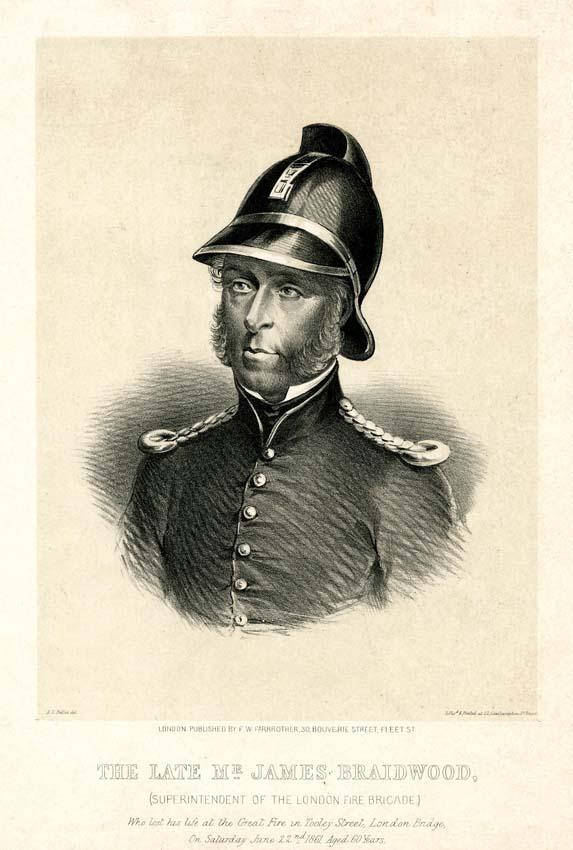
A lithograph portrait of James Braidwood wearing fire brigade uniform and helmet
Credit: © The Trustees of the British Museum, released as Creative Commons BY-NC-SA 4.0

